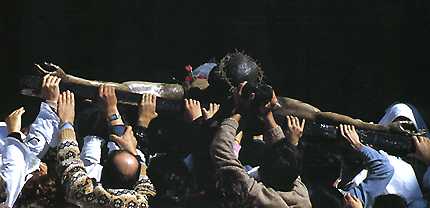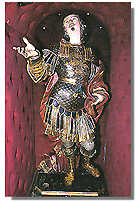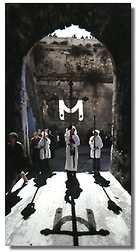
The statue of saint Efisio sculpted by Giuseppe Antonio Lonis appeared in the votive
procession that occurs even today on Easter Monday to celebrate a miracle for which
the saint was considered responsible. During a French naval attack on the city in
1793, prayers to the saint were answered. Saint Efisio was supposed to have miraculously
stopped the most dangerous bombs from inflicting their damage on the city and a strong
wind sent the French fleet battering against the rocks.
Early in the morning, the procession (organized by the Archconfraternity del Gonfalone)
leaves from the Stampace church and makes its way towards the Cathedral. The rite,
originating as a prologue to the May festival dedicated to the saint, concludes the
Lenten period. In Cagliari, as in many other places on the island, these ceremonies
are celebrated with ancient medieval rites having a strong Spanish influence.
A similar procession having Spanish origins begins again on Good Friday, at about
3:00 P.M. From the Oratorio del Crocefisso in Piazza S.Giacomo, it passes through
Via Sulis, Via Garibaldi and Via Sonnino with the Christ figure finally reaching
its destination, the church of S.Lucifero. Later in the evening on the following day, the figure
makes its return trip to the church of S.Giacomo where it arrives punctually at midnight.

At 11:00 A.M. on Easter day, the encounter (s'incontru)
between the statue of the Risen Christ and the Madonna takes place.
The clothing of
the two images symbolizes the Resurrection. Christ is clothed in a pink and gold
sash with a halo surrounding his head. The Madonna wears a white gown with gold trim,
a blue cape, lace veil, a crown, and holds a bouquet of flowers in her hand.
The ceremony
begins in Piazza S.Giacomo and terminates at Via Garibaldi. Facing each other, the
images greet with three bows and then make their way side by side to the church of
S.Giacomo. From there, the following Sunday, they are moved to the nearby Oratorio del
Crocefisso where they usually reside.
|









